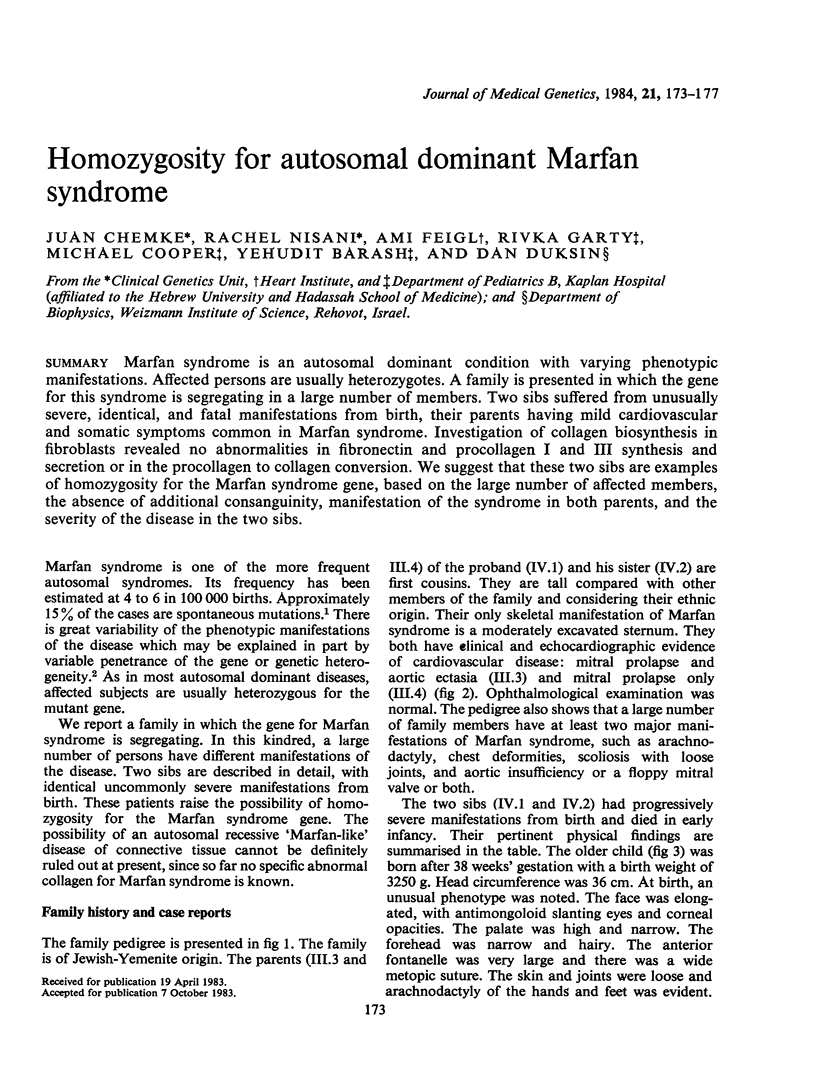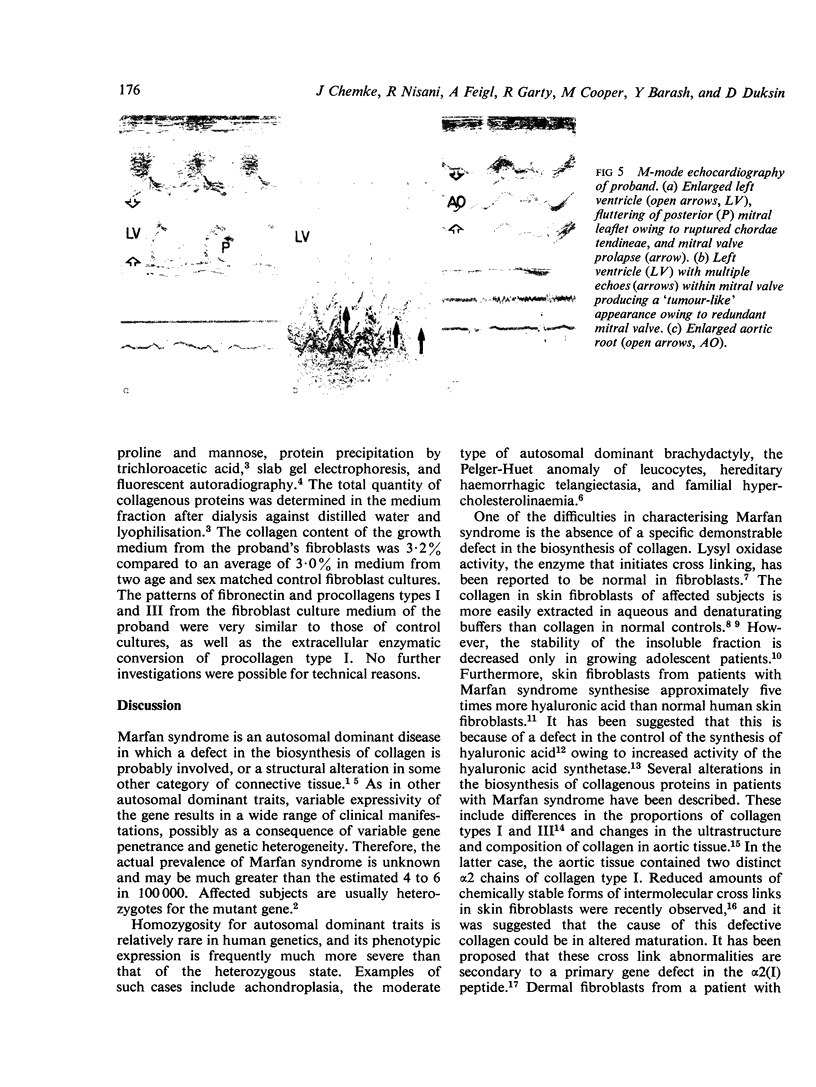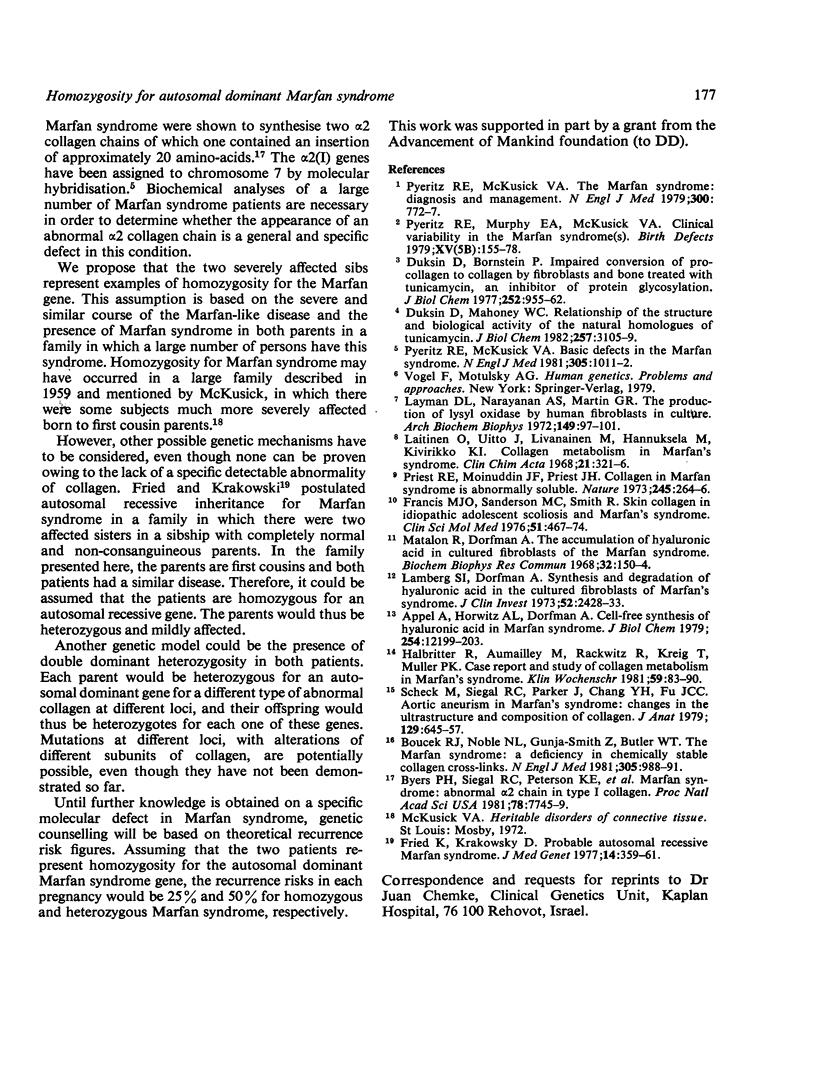Abstract
Marfan syndrome is an autosomal dominant condition with varying phenotypic manifestations. Affected persons are usually heterozygotes. A family is presented in which the gene for this syndrome is segregating in a large number of members. Two sibs suffered from unusually severe, identical, and fatal manifestations from birth, their parents having mild cardiovascular and somatic symptoms common in Marfan syndrome. Investigation of collagen biosynthesis in fibroblasts revealed no abnormalities in fibronectin and procollagen I and III synthesis and secretion or in the procollagen to collagen conversion. We suggest that these two sibs are examples of homozygosity for the Marfan syndrome gene, based on the large number of affected members, the absence of additional consanguinity, manifestation of the syndrome in both parents, and the severity of the disease in the two sibs.
Full text
PDF




Images in this article
Selected References
These references are in PubMed. This may not be the complete list of references from this article.
- Appel A., Horwitz A. L., Dorfman A. Cell-free synthesis of hyaluronic acid in Marfan syndrome. J Biol Chem. 1979 Dec 10;254(23):12199–12203. [PubMed] [Google Scholar]
- Boucek R. J., Noble N. L., Gunja-Smith Z., Butler W. T. The Marfan syndrome: a deficiency in chemically stable collagen cross-links. N Engl J Med. 1981 Oct 22;305(17):988–991. doi: 10.1056/NEJM198110223051705. [DOI] [PubMed] [Google Scholar]
- Byers P. H., Siegel R. C., Peterson K. E., Rowe D. W., Holbrook K. A., Smith L. T., Chang Y. H., Fu J. C. Marfan syndrome: abnormal alpha 2 chain in type I collagen. Proc Natl Acad Sci U S A. 1981 Dec;78(12):7745–7749. doi: 10.1073/pnas.78.12.7745. [DOI] [PMC free article] [PubMed] [Google Scholar]
- Duksin D., Bornstein P. Impaired conversion of procollagen to collagen by fibroblasts and bone treated with tunicamycin, an inhibitor of protein glycosylation. J Biol Chem. 1977 Feb 10;252(3):955–962. [PubMed] [Google Scholar]
- Duksin D., Mahoney W. C. Relationship of the structure and biological activity of the natural homologues of tunicamycin. J Biol Chem. 1982 Mar 25;257(6):3105–3109. [PubMed] [Google Scholar]
- Francis M. J., Sanderson M. C., Smith R. Skin collagen in idiopathic adolescent scoliosis and Marfan's syndrome. Clin Sci Mol Med. 1976 Nov;51(5):467–474. doi: 10.1042/cs0510467. [DOI] [PubMed] [Google Scholar]
- Fried K., Krakowsky D. Probable autosomal recessive Marfan syndrome. J Med Genet. 1977 Oct;14(5):359–361. doi: 10.1136/jmg.14.5.359. [DOI] [PMC free article] [PubMed] [Google Scholar]
- Halbritter R., Aumailley M., Rackwitz R., Krieg T., Müller P. K. Case report and study of collagen metabolism in Marfan's syndrome. Klin Wochenschr. 1981 Jan 15;59(2):83–90. doi: 10.1007/BF01477287. [DOI] [PubMed] [Google Scholar]
- Laitinen O., Uitto J., Iivanainen M., Hannuksela M., Kivirikko K. I. Collagen metabolism of the skin in Marfan's syndrome. Clin Chim Acta. 1968 Sep;21(3):321–326. doi: 10.1016/0009-8981(68)90062-4. [DOI] [PubMed] [Google Scholar]
- Lamberg S. I., Dorfman A. Synthesis and degradation of hyaluronic acid in the cultured fibroblasts of Marfan's disease. J Clin Invest. 1973 Oct;52(10):2428–2433. doi: 10.1172/JCI107433. [DOI] [PMC free article] [PubMed] [Google Scholar]
- Layman D. L., Narayanan A. S., Martin G. R. The production of lysyl oxidase by human fibroblasts in culture. Arch Biochem Biophys. 1972 Mar;149(1):97–101. doi: 10.1016/0003-9861(72)90302-5. [DOI] [PubMed] [Google Scholar]
- Matalon R., Dorfman A. The accumulation of hyaluronic acid in cultured fibroblasts of the Marfan syndrome. Biochem Biophys Res Commun. 1968 Jul 26;32(2):150–154. doi: 10.1016/0006-291x(68)90361-6. [DOI] [PubMed] [Google Scholar]
- Priest R. E., Moinuddin J. F., Priest J. H. Letter: Collagen of Marfan syndrome is abnormally soluble. Nature. 1973 Oct 5;245(5423):264–266. doi: 10.1038/245264a0. [DOI] [PubMed] [Google Scholar]
- Pyeritz R. E., McKusick V. A. Basic defects in Marfan syndrome. N Engl J Med. 1981 Oct 22;305(17):1011–1012. doi: 10.1056/NEJM198110223051711. [DOI] [PubMed] [Google Scholar]
- Pyeritz R. E., McKusick V. A. The Marfan syndrome: diagnosis and management. N Engl J Med. 1979 Apr 5;300(14):772–777. doi: 10.1056/NEJM197904053001406. [DOI] [PubMed] [Google Scholar]
- Pyeritz R. E., Murphy E. A., McKusick V. A. Clinical variability in the Marfan syndrome(s). Birth Defects Orig Artic Ser. 1979;15(5B):155–178. [PubMed] [Google Scholar]
- Scheck M., Siegel R. C., Parker J., Chang Y. H., Fu J. C. Aortic aneurysm in Marfan's syndrome: changes in the ultrastructure and composition of collagen. J Anat. 1979 Oct;129(Pt 3):645–657. [PMC free article] [PubMed] [Google Scholar]






